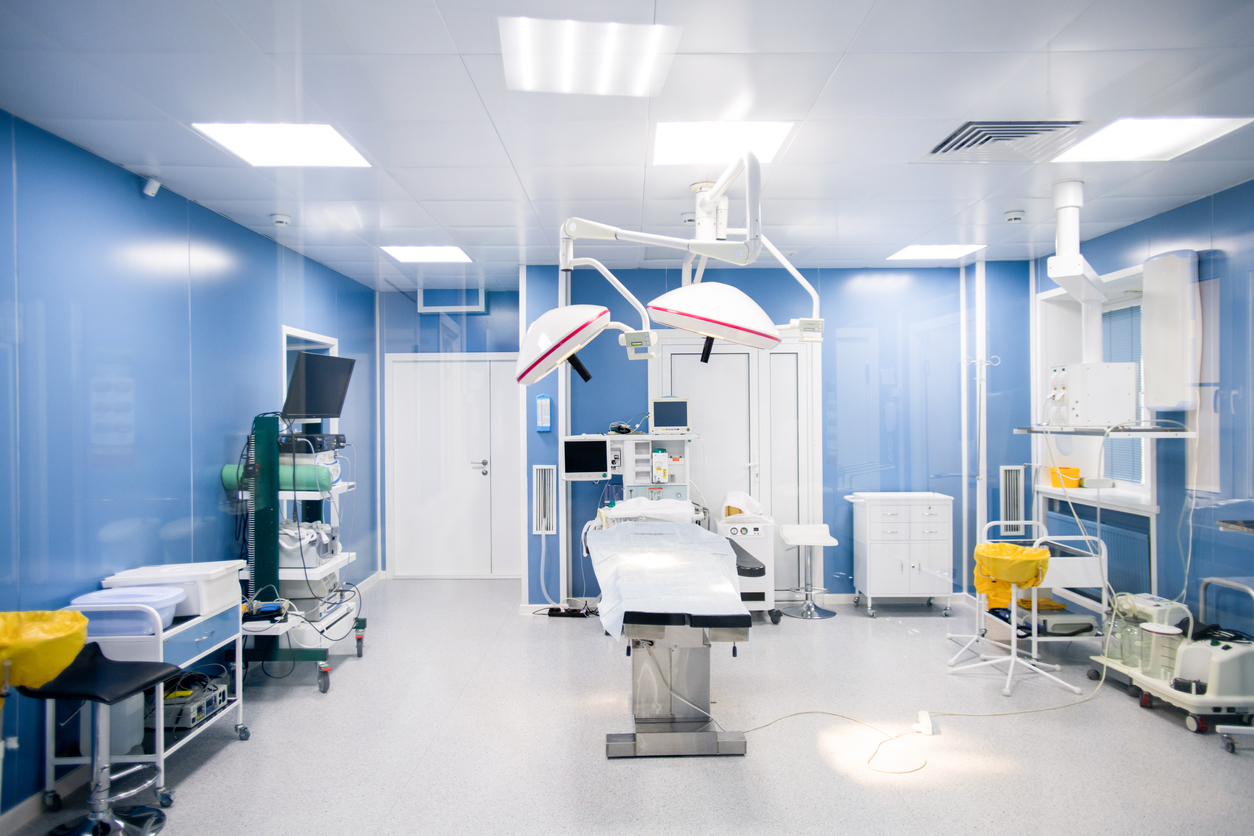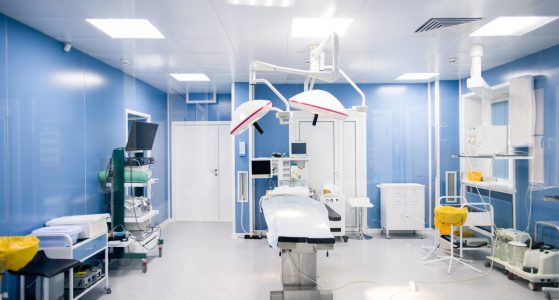
Healthcare facilities face serious challenges with mitigating the spread of germs and are seeking enhanced methods of disinfection such as hospital UV disinfection systems. Healthcare-associated infections (HAIs) cause nearly 100,000 deaths in the U.S. annually with approximately 1 in 25 people contracting an infection from their hospital stay. HAIs cause unnecessary deaths and put patients and staff at an increased risk.
The hospital environment plays a critical role in the transmission of pathogens, as many harmful viruses and bacteria can remain on surfaces for weeks, months, and even years. Superbugs which are resistant to antibiotics such as Methicillin-resistant Staphylococcus aureus (MRSA) and Vancomycin-Resistant Enterococci (VRE) pose additional challenges to keeping patients and hospital staff safe from infection.
Challenges in Disinfecting Hospital Rooms and Surfaces
Many challenges exist in preventing the spread of infection in hospital rooms and surfaces. Disease outbreaks have been traced back to many sources such as thermometers, blood pressure cuffs, sinks, and counters in patient rooms, and computer keyboards. This puts hospital staff at risk of contracting and spreading dangerous pathogens.
Hospital staff are expected to thoroughly clean patient rooms and use disinfectants known to kill pathogens of a previously infected patient. Some chemical disinfectants may require a long exposure time to provide effective disinfection and may not even be applied to all infected surfaces. Cleaning materials themselves such as mops or cleaning cloths may also become a source of transmission, spreading harmful pathogens rather than eliminating them.
Due to these challenges facing the healthcare environment with ineffective chemical treatments and the resistance of certain pathogens, it is imperative to incorporate enhanced disinfection with hospital UV disinfection.
Enhanced Disinfection with Hospital UV Disinfection
UV disinfection in hospitals is becoming an extremely popular method of assuring protection against the spread of harmful diseases, with a high rate of efficacy. According to a study published by Cambridge University, UV disinfection systems reported >99.99% effectiveness in eliminating resistant pathogens such as:
- Middle Eastern respiratory syndrome coronavirus (MERS-CoV) which had a reported mortality rate of approximately 36%
- Severe acute respiratory syndrome (SARS)
- Mouse hepatitis virus, strain A59 (MHV-A59)
UV disinfection systems provide a high rate of efficacy, although they are most effective in hospitals when used in addition to standard cleaning of hard surfaces and should never be considered a substitute for good cleaning practices.
Automatic UV Disinfection Systems for Hospitals
UV disinfection in hospitals is gaining traction due to the high rate of effectiveness and also because of the ability to automate the disinfection process. Many types of hospital UV disinfection systems are available such as:
- Portable UVC robots and UVC light carts
- Stationary solutions such as UVC lamps in light fixtures, overhead doors, and doorways
- UVC lamps in HVAC systems disinfect the air
- UVC lamps in water systems for clean water supply
With a wide range of UVC disinfection systems available to incorporate into hospitals and healthcare facilities, automating an effective UV disinfection solution is much more attainable than in previous years. Integrating UV disinfection systems with building management systems allows for facility managers to activate UV light disinfection systems on demand or as an automatic cycle in various areas of the hospital.
Automated hospital UV disinfection systems provide an invaluable benefit to protect patients and staff as well as cost-effective operation with no required labor. Activating automated UV disinfection in operating rooms after surgeries and prior to new patient arrivals adds a protective layer to manual cleaning and can reach odd places that may get overlooked during manual cleaning processes.
A study published by the National Institute of Health (NIH) in 2013, concluded that an automated hospital UVC system led to a significant decrease in the total number of colony-forming units (CFUs) of many types of organisms including Vancomycin-Resistant Enterococci (VRE), C. difficile and Acinetobacter.
Hospitals can incorporate automated UV disinfection systems in operating rooms, patient rooms, labs, storage facilities and on equipment surfaces. UVC germicidal lamps offer an enhancement to traditional cleaning methods and are proven to be more effective than cleaning with chemicals alone.
LightSources Offers UVC Lamps for Any Hospital Disinfection System
For over 35 years, LightSources has been offering superior products and processes to OEMs as a world leader in the manufacturing of quartz germicidal lamps. Our partner company, LightTech in Hungary, allows us to provide prompt service of quality UV germicidal lamp solutions to our customers in Europe and Asia.
LightSources and LightTech design and produce UV germicidal lamps with peak UV output at 254nm for maximum effectiveness, 185nm ozone-producing lamps, and a wide selection of UVC lamp types for various applications:
- Amalgam Lamps
- Quartz Germicidal Lamps:
- High output lamps
- Standard output lamps
- Germipak UV Cell lamps
- U-lamps
- Subminiature UVC lamps
- R.P.T. UVC lamps
- All-in-one submersible UVC lamps
- Soft Glass Germicidal Lamps:
- Standard and HO lamps
- Compact lamps
- Medium Pressure UV Lamps
- Custom MP UV lamps
- High-Pressure UV Lamps
- Custom HP UV lamps
- Quartz sleeves
- Shatter+ Protech technology
- Proprietary Bases and Sockets
Low-Pressure Amalgam UV Disinfection Lamps
LightSources provides the widest selection of high-quality pellet and spot amalgam technology in the lamp industry, with both standard and custom-engineered solutions available. Our amalgam lamps deliver the same high performance in either vertical or horizontal operations and yield up to three times the UVC output of other lamps comparable in length. Proprietary LongLife+ technology is applied to our amalgam line to reduce output depreciation, contributing to a long useful life of up to 16,000 hours with end-of-life output at 90% of initial UVC output. We offer a wide selection of spot and pellet amalgam lamps with custom sizes, shapes and UVC output available.
Quartz Germicidal Lamps
The type of fused quartz used in the lamp body determines UV wavelength emissions. Low ozone quartz delivers 90% emissions at 254nm, while very high ozone (VH) lamps clear fused quartz emit both 185nm and 254nm. Synthetic quartz is also available for an even higher ozone emission at 185nm. LightSources offers a wide selection of quartz lamps, standard output, high output, Germipak UV Cell germicidal lamps, and U-shaped quartz germicidal lamps.
Soft Glass Germicidal Lamps
Soft glass offers more variety with sizes and shapes than quartz glass with a wide range of operating currents. We engineer soft glass germicidal lamps with the highest in quality material and a wide range of sizes. Soft glass germicidal lamps are an economical option over quartz lamps, with custom shapes and sizes available.
LAMP PRODUCT DATA:
UV Germicidal LampsLAMP Applications:
UV Germicidal ApplicationsLightSources and LightTech lead the industry with germicidal UV lamp solutions for any application, including air, surface and water disinfection. We offer high-tech lamps, proprietary technology and custom designed germicidal lamps to meet specific requirements. Contact us to speak with an engineer and to learn more about our germicidal lamp options for hospital UV disinfection.




